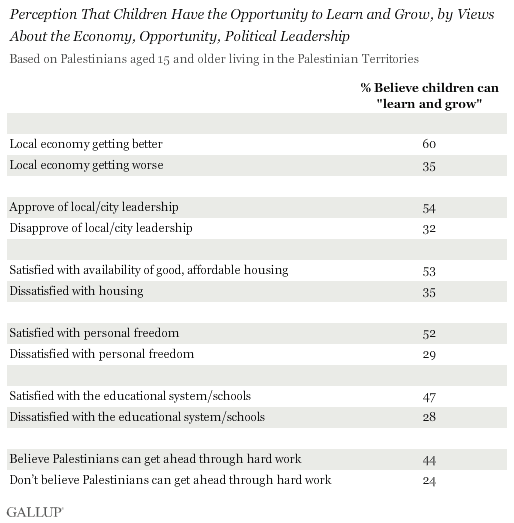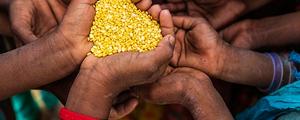PRINCETON, NJ -- Palestinians and Israelis have consistently differed in their perceptions of the quality of life for children where they live. Most recently, in 2012, 73% of Israelis versus 56% of Palestinians living in the West Bank and 39% living in the Gaza Strip say children "in their country" are "treated with respect and dignity."

These findings come from Gallup surveys conducted in Israel and the Palestinian Territories in 2012, prior to the Israeli-Gaza conflict in November.
Israelis' views about children in Israel being respected have been fairly steady over the past six years, with a slight improvement seen since 2010. By contrast, Palestinians' views have shown more variability over this time period, possibly related to internal conflict in the Palestinian Territories and aspects of the conflict with Israel.
Approximately one-third of Palestinians living in the West Bank and Gaza Strip in January 2006 -- prior to Palestinian elections and subsequent outbreak of violence between the Hamas and Fatah political factions -- said children there were treated with respect and dignity. This view fell sharply among both groups in July 2007, shortly after rival governments were established in the two regions. However, attitudes have since improved at a faster pace in the West Bank than in the Gaza Strip. And in 2012, perceptions about respect for children continued to gain ground in the West Bank while deteriorating in the Gaza Strip.
People Living in West Bank and Gaza Strip Equally Doubtful About Children's Opportunities
Gallup has typically found less difference between Palestinians living in the West Bank and those living in the Gaza Strip on the question of whether children in the Palestinian Territories "have the opportunity to learn and grow every day." The 47% vs. 37% in each region in 2012 saying children can learn and grow is statistically similar; the gap in views was even smaller in prior years.
Israelis' views on this question are far more positive than those of both Palestinian groups, with 74% in 2012 saying children in Israel have the opportunity to learn and grow. That represents a slight improvement over 2006 through 2009 when fewer than 70% felt this way.
Although Palestinians' optimism about opportunity for children still lags behind Israelis', it has nearly doubled since the low points recorded in 2007. Most of the gains seen among West Bank Palestinians and Gazans were made between 2007 and 2009, possibly reflecting the influx of international monetary aid to the Palestinians during that period. Since then, views about opportunity for children have been generally steady, except for an uptick in positive views in the West Bank in 2012 and a slight decline in opinions in the Gaza Strip in 2012.

Views About Children Linked to Ratings of Local Economy and Leadership
Palestinians' views about respect and opportunities for children in the Palestinian Territories are to some degree related to how they feel about their broader living conditions, particularly their economy and political leadership. This may explain why Palestinians' views about opportunities for children align more with developing countries than developed ones such as Israel.
More specifically, Palestinians who are generally upbeat about economic opportunity, the direction of their local economy, their personal freedom, and the job performance of local leaders are much more likely to believe children are treated with respect and dignity or have the opportunity to learn and grow than Palestinians who are more cynical about these local conditions. Palestinians' satisfaction ratings with the quality of education and housing are also closely related to their views about the status of children.

Bottom Line
Regardless of the root causes of Palestinians' perceptions about conditions for children, the differences between Israelis and Palestinians on these measures underscore the vast gulf between the peoples' lives and general outlook. Further, the gap between Palestinians living in the Gaza Strip and those living in the West Bank may highlight the more difficult economic and political circumstances in the former.
The 74% of Israelis believing children in Israel have the opportunity to learn and grow is a bit higher than the average 68% Gallup found worldwide in 2012 and is only slightly lower than in the United States (80%). By contrast, perceptions on this question among Palestinians, and in particular among Gazans, are among the lowest worldwide, on par with other countries suffering from serious political strife or economic crises, including Lebanon, Iraq, Sudan, the Democratic Republic of the Congo, and Ukraine.
Given their physical and emotional vulnerabilities, children tend to suffer more from the hardships imposed by war and poverty than adults, and shortfalls in nutrition and education arising from such difficulties in childhood can create lifelong problems. Although the Israeli-Palestinian conflict has important implications for the quality of life of both peoples, the status of children in the Palestinian Territories is especially precarious. Doubts abound among Palestinians living in both the West Bank and Gaza Strip about whether children have the opportunity to learn and grow and whether they are treated with the respect and dignity they deserve. As efforts are made to improve economic and political conditions in the Palestinian Territories, attention to how Palestinians believe children are faring could be as useful as GDP and other hard economic metrics for determining if these efforts are succeeding.
For complete data sets or custom research from the more than 150 countries Gallup continually surveys, please contact us.
Survey Methods
Results for Israel are based on approximately 1,000 face-to-face interviews each year with adults, aged 15 and older. Surveys were conducted in September 2012, December 2011, November 2010, December 2009, October 2008, August 2007, and July 2006. For results based on the total sample of national adults, one can say with 95% confidence that the maximum margin of sampling error for each year is ±3.5 percentage points. The margin of error reflects the influence of data weighting. In addition to sampling error, question wording and practical difficulties in conducting surveys can introduce error or bias into the findings of public opinion polls.
Results for the West Bank are based on between 520 and 540 face-to-face interviews each year with adults, aged 15 and older. For the question about children being treated with respect and dignity, the surveys were conducted in March 2012, September 2011, August 2010, August 2009, August 2008, July 2007, and January 2006. For the question about children having the opportunity to learn and grow, the surveys were conducted in September 2012, September 2011, August 2010, August 2009, August 2008, July 2007, and January 2006. For results based on the total sample of West Bank adults, one can say with 95% confidence that the maximum margin of sampling errors are ±6 percentage points. The margin of error reflects the influence of data weighting. In addition to sampling error, question wording and practical difficulties in conducting surveys can introduce error or bias into the findings of public opinion polls.
Results for the Gaza Strip are based on between 360 and 375 face-to-face interviews each year with adults, aged 15 and older. For the question about children being treated with respect and dignity, the surveys were conducted in March 2012, September 2011, August 2010, August 2009, August 2008, July 2007, and January 2006. For the question about children having the opportunity to learn and grow, the surveys were conducted in September 2012, September 2011, August 2010, August 2009, August 2008, July 2007, and January 2006. For results based on the total sample of Gaza Strip adults, one can say with 95% confidence that the maximum margin of sampling errors are ±7 percentage points. The margin of error reflects the influence of data weighting. In addition to sampling error, question wording and practical difficulties in conducting surveys can introduce error or bias into the findings of public opinion polls.
For more complete methodology and specific survey dates, please review Gallup's Country Data Set details.
